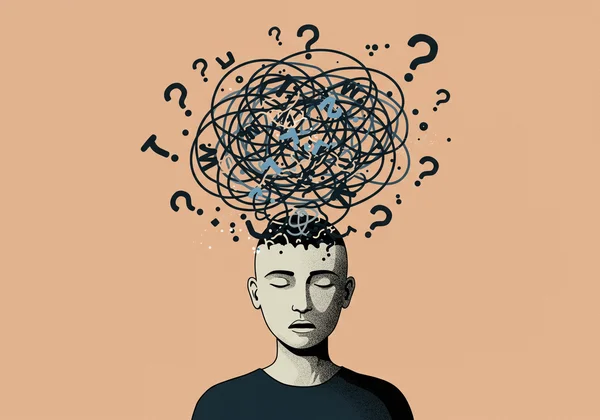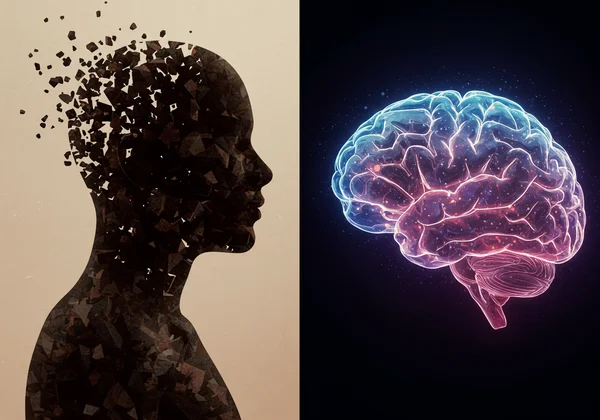在线成人述情障碍测试:了解症状与成因
即使你知道自己深受情感影响,却总是难以给自己的感受命名?或者,也许你只是对他人表达情感的轻松程度感到困惑。如果“情感疏离”这样的词语,或者 “ 什么是述情障碍的症状? ” 这样的问题让你感同身受,你可能正在接触一种称为述情障碍的特质。这并非一种疾病,而是一种影响情感自我意识的独特特征。
理解这种特质是走向更深刻的自我认知和更丰富人际关系的第一步。本指南将阐明 “ 什么是述情障碍 ”,帮助你识别其迹象和潜在成因。如果你对自己的情感世界感到好奇,一个很好的开始方式是 参加我们的免费测试 以获得初步的见解。这场自我探索之旅可以赋予你力量,引领你走向更充实的人生。

理解述情障碍:核心定义
述情障碍(Alexithymia),源自希腊语,意为“没有表达情感的词语”,是一种人格特质,其特征是难以识别和描述自己的情绪。这并非意味着一个人没有情感;具有高述情障碍特质的人们会感受到情绪,但他们难以识别、理解和表达这些情绪。他们可能不会说“我感到悲伤”,而是会描述身体上的感觉,例如胃里一阵翻腾或感到疲倦。
你所感受到的和你能够有意识处理的之间的这种脱节,可能会让你感到非常困惑。但重要的是要记住:这是一个信息处理问题,而不是性格缺陷。述情障碍的核心在于情绪内省能力减弱,以及倾向于关注外部事件而非内在感受。
** 述情障碍 并非 什么:与冷漠的区别 **
区分述情障碍和冷漠(Apathy)或缺乏共情(Empathy)是至关重要的。冷漠是指缺乏兴趣、热情或关怀。同理心是指理解和分享他人感受的能力。一个具有高述情障碍特质的人仍然可以深切关心他人,并被他们的处境所感动;他们主要的挑战在于处理和表达 自己的 内在情感状态。他们可能知道朋友的情况很糟糕并提供支持,但却难以给自己相应的悲伤情绪命名。
述情障碍的核心特质与特征
心理学界普遍认同几个核心特征来定义这一特质。理解这些特征可以帮助你判断它们是否与你的自身经历相符。
- 难以识别感受(DIF): 这是核心方面。它指的是在任何给定时刻,都难以知道自己正经历何种具体情绪。你可能感到“不舒服”或“不对劲”,但却无法区分这种感觉是焦虑、愤怒还是兴奋。
- 难以描述感受(DDF): 即使能模糊地识别出一种情绪,用语言向他人(甚至自己)表达出来也是一个主要的困难。这会使人际沟通尤其充满挑战。
- 外向型思维(EOT): 这指的是一种思维方式,它侧重于事件的具体外部细节,而非内在的情感体验。当被问及对一部电影的感受时,一个具有高 EOT 的人可能会详细描述情节,而不是它所唤起的情感。
如果这些描述听起来很熟悉,通过 在线述情障碍测试 进一步探索,可以为你提供一个结构化的方式来反思自己的个人模式。
识别迹象:常见的述情障碍症状
由于述情障碍是一种特质而非诊断,其“症状”更适合被描述为可观察到的行为和内在体验。这些迹象因人而异,其强度也可能不同。
常见迹象包括:
- 情感词汇有限;常使用“好”或“坏”等笼统的词语。
- 对与情感相关的身体感觉感到困惑(例如,将焦虑误认为是胃痛)。
- 解决问题的方式是逻辑性和实用性的,很少涉及情感。
- 难以识别他人细微的情感线索,如面部表情或语调。
- 在他人眼中显得疏离、僵化或缺乏幽默感。
- 幻想生活有限,做梦频率低。
- 倾向于独处或从事不涉及情感投入的活动。
如何识别高述情障碍特质
识别自己身上的这些特质需要诚实的自我反思。问问自己:当有人问“你感觉怎么样?”时,你是否经常简单地回答“还好”,因为你真的不知道还能说什么?你是否发现自己更关注压力的身体症状,如头痛或肌肉紧张,而不是潜在的情感根源?如果这些问题的答案是“是”,可能表明你具有某些述情障碍的特质。 述情障碍问卷 旨在帮助你更深入地探讨这些问题。

述情障碍对日常生活和人际关系的影响
述情障碍的挑战会显著影响日常生活。在人际关系中,伴侣可能会感到不被爱,或认为你情感上无法触及,仅仅因为你难以在言语上表达爱意或同情。这可能导致误解和冲突,正如“与述情障碍者约会”这个常见问题所体现的。
在职业方面,它会使人难以处理职场政治、与同事建立联系或应对情绪化的反馈。对许多人来说,它会造成一种持续的、低程度的与世界和自我脱节的感觉,这可能导致焦虑或抑郁感。
探究根源:述情障碍的成因?
述情障碍没有单一的成因。相反,它被认为是由遗传、神经和环境因素共同作用的结果。这是一个复杂特质,研究仍在努力完全理解它。对许多人来说,了解其潜在的成因是自我发现的关键部分。
述情障碍是创伤反应吗?
最重要的相关因素之一是创伤。对于经历过严重创伤,尤其是在童年时期(如虐待或忽视)的人来说,情绪麻木感可能成为一种生存机制。大脑为了保护自己,学会了与压倒性的感受断开联系。随着时间的推移,这种应对策略可能成为一种永久的特质,导致所谓的继发性述情障碍。
生物和发育因素
除了创伤,还有其他潜在的促成因素。一些研究表明,大脑负责情绪处理的区域存在差异,这在神经科学研究中有探讨。述情障碍也经常与某些神经发育障碍相关。例如, 述情障碍与自闭症 (ASD)和注意力缺陷多动障碍(ADHD)之间存在很强的联系。需要注意的是,并非所有患有这些疾病的人都有述情障碍,也并非所有有述情障碍的人都是神经多样性人群,但两者之间存在显著的重叠。

探索变体:述情障碍的类型
为了更好地理解这种特质,专家们区分了两种主要类型。这种区分可以为理解其成因和潜在的成长途径提供见解。
原发性与继发性述情障碍:理解差异
原发性述情障碍 被认为是一种持久、稳定的性格特质,可能从早期就开始存在。它可能更多地与遗传或神经因素有关。它仅仅是一个人天生就有的处理世界的方式。
继发性述情障碍,正如前面提到的,通常在生命后期获得,是由于心理创伤或长期、严重压力引起的。它也可能因脑损伤或慢性疾病等医疗状况而发展。与原发性述情障碍不同,继发性述情障碍的强度可能会波动,并且有时可以通过解决根本原因来改善,例如在治疗中处理创伤。
开始你的旅程:理解你的情感世界
了解述情障碍并非是为了给自己贴标签,而是为了获得一种自我理解的框架。识别这些特质可能是一种解放的体验,为长期的困惑或疏离感提供解释。它为你打开了发展新策略的大门,以应对内在世界并改善人际关系。
旅程始于好奇。如果这篇文章激发了你的兴趣,下一步就是探索你自己的情感认知模式。我们基于科学的 述情障碍测试 是一个完美的起点。你可以选择 获得快速评分以获得即时见解,或选择我们独特的人工智能个性化报告,它提供深入的分析和为你量身定制的可行步骤。

免责声明:本网站及其测试仅用于信息和教育目的。它们不能替代专业的医疗建议、诊断或治疗。如果您对自己的心理健康有顾虑,请咨询合格的医疗保健专业人员。
关于述情障碍的常见问题
如何判断自己是否患有述情障碍?
最可靠的第一步是通过核心特质进行自我反思:难以识别感受,难以描述感受,以及倾向于外在的思维模式。如果这些让你深有体会,那么参加像我们的 在线述情障碍测试 这样的结构化评估,可以为你提供更客观的个人模式见解。
可以自行诊断述情障碍吗?
述情障碍是一种人格特质,而非 DSM-5 中的临床诊断。因此,“自行诊断”这个说法不太准确。但是,你可以通过自我评估工具和个人反思来识别自己是否具有述情障碍的较高特质。这些工具用于自我探索,而非替代与心理健康专业人士的咨询。
述情障碍是创伤反应吗?
它可能是。继发性述情障碍通常被认为是创伤反应,在这种情况下,情绪麻木感成为一种长期的应对机制。然而,原发性述情障碍被认为是一种更内在、更稳定的特质,与创伤无关。这种关系很复杂,并且因人而异。
述情障碍者会哭吗?
是的,当然可以。哭泣通常是对强烈的情绪刺激的生理反应,即使一个人无法有意识地给驱动它的情绪命名,也可能会哭。他们可能在看悲伤的电影时哭,但会将其描述为“生理上的释放”,或者说“我不知道为什么在哭”,这突显了生理行为与情绪的认知理解之间的脱节。